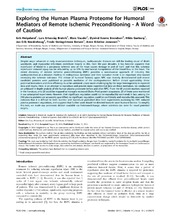| dc.contributor.author | Helgeland, Erik | en_US |
| dc.contributor.author | Breivik, Lars Ertesvåg | en_US |
| dc.contributor.author | Vaudel, Marc | en_US |
| dc.contributor.author | Svendsen, Øyvind Sverre | en_US |
| dc.contributor.author | Garberg, Hilde Kristin | en_US |
| dc.contributor.author | Nordrehaug, Jan Erik | en_US |
| dc.contributor.author | Berven, Frode S. | en_US |
| dc.contributor.author | Jonassen, Anne Kristin | en_US |
| dc.date.accessioned | 2015-03-13T08:17:07Z | |
| dc.date.available | 2015-03-13T08:17:07Z | |
| dc.date.issued | 2014-10-15 | eng |
| dc.identifier.issn | 1932-6203 | |
| dc.identifier.uri | https://hdl.handle.net/1956/9527 | |
| dc.description.abstract | Despite major advances in early revascularization techniques, cardiovascular diseases are still the leading cause of death worldwide, and myocardial infarctions contribute heavily to this. Over the past decades, it has become apparent that reperfusion of blood to a previously ischemic area of the heart causes damage in and of itself, and that this ischemia reperfusion induced injury can be reduced by up to 50% by mechanical manipulation of the blood flow to the heart. The recent discovery of remote ischemic preconditioning (RIPC) provides a non-invasive approach of inducing this cardioprotection at a distance. Finding its endogenous mediators and their operative mode is an important step toward increasing the ischemic tolerance. The release of humoral factor(s) upon RIPC was recently demonstrated and several candidate proteins were published as possible mediators of the cardioprotection. Before clinical applicability, these potential biomarkers and their efficiency must be validated, a task made challenging by the large heterogeneity in reported data and results. Here, in an attempt to reproduce and provide more experimental data on these mediators, we conducted an unbiased in-depth analysis of the human plasma proteome before and after RIPC. From the 68 protein markers reported in the literature, only 28 could be mapped to manually reviewed (Swiss-Prot) protein sequences. 23 of them were monitored in our untargeted experiment. However, their significant regulation could not be reproducibly estimated. In fact, among the 394 plasma proteins we accurately quantified, no significant regulation could be confidently and reproducibly assessed. This indicates that it is difficult to both monitor and reproduce published data from experiments exploring for RIPC induced plasma proteomic regulations, and suggests that further work should be directed towards small humoral factors. To simplify this task, we made our proteomic dataset available via ProteomeXchange, where scientists can mine for novel potential targets. | en_US |
| dc.language.iso | eng | eng |
| dc.publisher | PLoS | eng |
| dc.rights | Attribution CC BY | eng |
| dc.rights.uri | http://creativecommons.org/licenses/by/4.0/ | eng |
| dc.title | Exploring the human plasma proteome for humoral mediators of remote ischemic preconditioning - A word of caution | en_US |
| dc.type | Peer reviewed | |
| dc.type | Journal article | |
| dc.date.updated | 2015-03-03T14:42:02Z | en_US |
| dc.description.version | publishedVersion | en_US |
| dc.rights.holder | Copyright 2014 Helgeland et al. | |
| dc.source.articlenumber | e109279 | |
| dc.identifier.doi | https://doi.org/10.1371/journal.pone.0109279 | |
| dc.identifier.cristin | 1213239 | |
| dc.source.journal | PLoS ONE | |
| dc.source.40 | 9 | |
| dc.source.14 | 10 | |
| dc.subject.nsi | VDP::Medical sciences: 700::Basic medical, dental and veterinary sciences: 710::Medical biochemistry: 726 | eng |
| dc.subject.nsi | VDP::Medisinske fag: 700::Basale medisinske, odontologiske og veterinærmedisinske fag: 710::Medisinsk biokjemi: 726 | nob |

